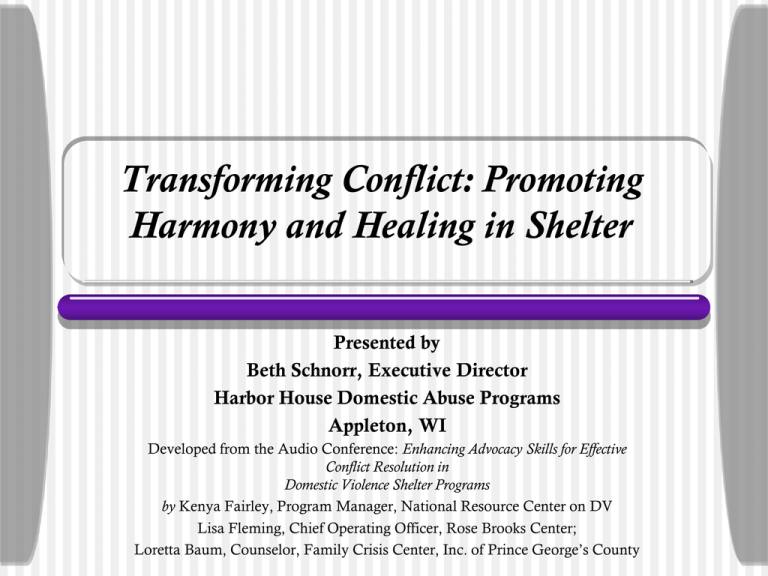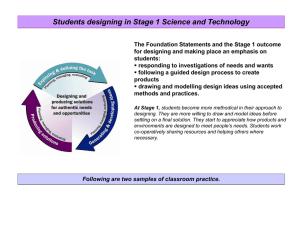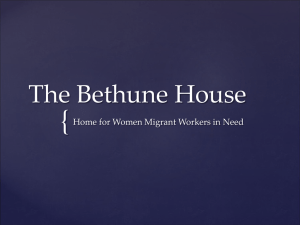Transforming Conflict: Promoting Harmony and Healing in Shelter
advertisement

Transforming Conflict: Promoting Harmony and Healing in Shelter Presented by Beth Schnorr, Executive Director Harbor House Domestic Abuse Programs Appleton, WI Developed from the Audio Conference: Enhancing Advocacy Skills for Effective Conflict Resolution in Domestic Violence Shelter Programs by Kenya Fairley, Program Manager, National Resource Center on DV Lisa Fleming, Chief Operating Officer, Rose Brooks Center; Loretta Baum, Counselor, Family Crisis Center, Inc. of Prince George’s County Workshop Goals • Increase understanding of the challenges associated with communal living • Explore different types of conflict • Examine ways to measure the intensity and impact of conflict within the shelter • Explore ways to reduce, resolve, contain, and regroup once conflict arises Meeting Survivors’ Needs: A Multi-State Study of Domestic Violence Shelter Experiences • Captured the voices and experiences of over 3,400 shelter residents in 215 programs across 8 states (CT, FL, IL, MI, NM, OK, TN, WA) • One section focused on the kinds of problems encountered by the shelter residents and the extent to which these problems were resolved Challenges to Shelter Living • Sudden change in family circumstances • Attending to their children’s reactions • Living in close proximity to other families • Finding privacy • Recovering from the crisis that led them to seek shelter • Getting along with other residents • Complying with shelter rules Main Challenges Identified by Survivors Resident Problems % Encountered % Resolved Conflict with other Residents 32% 73% Transportation 24% 54% Time limits 16% 50% Finding privacy 16% 47% Curfew 14% 61% Child discipline 13% 66% Chores 13% 59% Conflict with Staff 13% 49% Choices of food 13% 44% Key Areas of Conflict • Entering the Shelter New Community or Neighborhood Recovering from the effects of recent trauma/abuse Differences in culture and lifestyle Temporary nature of shelter living Adjustment to communal living environment • Settling in and adjustment to shelter living Time needed to understand and adjust to the shelter structure and support system Constant transition of families in/out of the shelter Difficulty establishing and/or maintaining a routine Challenges in finding privacy Key Areas of Conflict (continued) • Issues related to children and parenting Differences in parenting styles and expectations Limited services to assist parents with the children Prohibition of physical or corporal punishment Varying responses/coping strategies of children exposed to dv • Shelter rules and structure Some residents welcome structure while others experience it as overly structured/restrictive Rules/Guidelines followed and enforced to varying degrees Residents responding in crisis mode Impact of Domestic Violence on Children Impact of Abuse on Children • Mental/Emotional Health Heightened levels of anxiety Difficulty distinguishing right from wrong Sense of safety and security is compromised Depression / helplessness / hopelessness Fear of abandonment Feeling burdened: adult roles/care for siblings Guilt, shame, feelings of isolation Resentment towards one or both parents Impact of Abuse on Children (continued) • Physical Health Physical injuries Bed wetting (episodic or regressive) Trouble sleeping (inability to fall asleep, stay asleep, or nightmares) Eating problems Somatic complaints (headaches, stomach aches, body pains) Regression in development No reaction to pain at times • Education and Academics Difficulty learning Lack of motivation to participate in activities or complete goals Compensation or overachieving behaviors Impact of Abuse on Children (continued) • Behavior Infants may adapt to violent, stressful conditions Aggressive behavior Run aways Self-injurious behaviors Poor response to parental authority • Social/Interpersonal Relationships Inability to empathize with others Rigid stereotypes, perpetration of violence, and victimization Difficulty trusting May resist intimacy Poor conflict resolution skills Greater risk of being involved with dating violence Batterer Impact: Parent-Child Relationship • Direct/indirect interference with parenting Under duress, the victim-parent may not be able to fully attend to the needs of the children • Potential for child to absorb the batterer’s disrespect/contempt for the victim-parent This can lead to distance in the parent-child relationship Particularly prevalent in boys age 8 and older, and in both sexes as teenagers Batterer Impact: Parent-Child Rel. (continued) • Child may exhibit violence towards the victimparent Reproduction of battering behavior Assumption of batterer’s role after separation • Use of children as weapons while together and after separation Deliberate endangerment; neglect/maltreatment to pressure the victim-parent into reconciliation Threatening to take the children Use of children as vehicles for communication Shelter Rules Reduction and Elimination How rules create conflict • Purpose: to help ensure safety and wellbeing. • Monitoring and enforcement vs. build a trusting, respectful and equal relationship between staff and residents. • Role of monitor/enforcer strongly contradicts the core values and philosophies of our advocacy work. Reducing Shelter Rules Where to Start: Identify and describe your agency’s mission, vision, values and philosophies. Do current practices and rules support or conflict with your core values and philosophies? Where to Start (continued) Common Core Values and Beliefs: Safety and Respite from Violence and Control Empowerment Right to Self Determination Right to Accessible Services Where to Start (continued) • Implement as a Pilot Project. Try it out. If it doesn’t work you can change back to the old practices. • Establish new expectations for advocacy. Replace these monitoring functions with advocacy that support your values and beliefs. Establish new procedures for dealing with community living conflicts Focus on “What is a successful shelter stay?” Project Results • Fewer conflicts between staff and residents • Staff report better rapport in the absence of having to monitor and enforce rules. • Lessens the power and control staff have over residents • Fewer (or no) problems with chores, persons using drugs/alcohol, children’s bedtimes, etc. • Increase in positive results from resident satisfaction surveys • Average length of stay increased from 28 to 43 days What is Conflict in the Shelter Setting? Characteristics of Conflict • Conflict within the shelter setting cannot be avoided • Differing perceptions of need and how to get them met • Within the shelter setting, conflict may exist whether all parties are aware of it or not; the conflict escalates at the time that other parties become aware of its existence • When managed well, conflict can be a very valuable teaching tool; when managed poorly, conflict can become distracting, disruptive, and destructive within the shelter environment Desired Outcomes of Conflict Resolution Enhanced and more meaningful survivor/advocate relationship De-escalation of any additional or related tension or conflict Increased understanding of shelter/agency services, opportunities, and limitations Improved decision-making skills and increased understanding of how those decisions are made Resolutions that will satisfy the needs and remove the disruption from the shelter environment Desired Outcomes (continued) A change in survivor and advocate behavior that will reduce future conflict and enhance provision of services Reduction in tension/stress and better coping skills on the part of the survivor and advocate Increased opportunities for success on the part of the survivor and advocate to meet established goals Greater empowerment on the part of the survivor to continue working towards safety, independence, and self-sufficiency Greater cohesiveness amongst the shelter residents and staff to maintain a stable shelter environment Guidelines to resolving conflict situations • Respond in a timely manner in the best scenario possible • Prior to meeting with a resident(s) to discuss the conflict, process the situation with your supervisor or a colleague • It is best to plan ahead and determine which staff member is best suited to address the conflict • If possible, have a 2nd staff member sit-in on the discussion, determine their role and level of participation in advance Guidelines (continued) • Do not address the conflict situation until staff are able to remain calm and not take the resident(s) response personally, even if being verbally attacked or physically threatened Anger on the part of the survivor may be a very real and valid response to life and/or shelter stressors Allow survivor’s to express their feelings, help them process through it, re-direct their energy towards a more positive solution Rarely is the conflict about you as an individual; remember that conflict arises out of differing needs In times of crisis, people may sometimes behave in ways that they would not otherwise when they are safe and have their needs met. Handling the Discussion Human Resources, Univ. of California, Berkley • Acknowledge that a difficult situation exists. • Seek to understand • Let individuals express their feelings. • Define the problem. Determine the underlying need. • Find common areas of agreement, no matter how small. Agree on the problem Agree on the procedure to follow Agree on worst fears Agree on some small change to give an experience of success Handling the Discussion (continued) Human Resources, Univ. of California, Berkley • Find solutions to satisfy needs. Problem-solve by generating multiple alternatives. Determine which actions will be taken. Make sure involved parties buy into actions. • Determine follow-up you will take to monitor actions. • Determine what you’ll do if the conflict goes unresolved. Scenario 1 • Aisha requested a meeting with shelter staff to discuss Helen’s child Amy. On several occasions, Amy has burst into Aisha’s room without permission and on one occasion, Aisha came into the shelter from work and found Amy playing in her room with Aisha’s son’s toys. • Each time, Aisha has tried to resolve this matter with Helen, who has talked to her daughter Amy about boundaries and personal space. Unfortunately, Amy just yells at Helen or runs away and continues to do what she wants. Now, Aisha’s son’s Nintendo DS is missing and she believes that Amy has taken it. • Helen and Amy are headed out of the shelter to run errands and as Aisha is waiting for staff to talk to her, she decides to confront Helen in case they are leaving with the missing Nintendo DS. Questions to be explored • Should staff intervene or allow the confrontation to play itself out? Why or why not? • How might this conflict, and the details involved, impact the shelter environment? • Based on each families’ history of domestic violence, how should shelter staff work with each mother to resolve the conflict? How do they work with the children? • What recourse does Aisha have in this scenario? • What are the implications for the rules at the shelter regarding resident interaction, monitoring of children, theft, and privacy? Scenario 2 • Suki has been in the shelter for 3 months now, awaiting a final confirmation of her move-in date for transitional housing (it’s been rescheduled twice at this point). • She’s become increasingly frustrated with the slow response from the Housing Authority, and with the rules of the shelter which she finds to be very limiting and too strict. On a few occasions she’s been written up for not having her daughter in school during the weekday. • This morning, Suki’s frustrations boiled over and she screamed at the Shelter Director and made physically threatening gestures. Several residents saw this happen and now Suki has stormed out of the shelter. Questions to be explored • How do you respond to the residents who have witnessed this entire exchange? • What will be the staff response to Suki when she returns to the shelter? • What are the implications for your continued service provision to Suki and her daughter? • How might Suki’s past experiences with domestic violence and at the shelter, including past conflicts with staff, contribute to this situation? • What role might shelter rules, program or funding goals, and advocacy philosophy play in this situation? Scenario 3 • Recently, Kelly, the overnight weekend staff at the shelter, was out sick for a few days. Staff who filled in for her reported that a few women came in past curfew and two of them appeared inebriated. They made lots of noise and disturbed several of the children who had already been put to bed. • When confronted by relief staff, the residents said that Kelly lets them come in when they want to because it’s the weekend and she believes they need more freedom in the shelter. • To date, as the Shelter Director, you’ve received no reports that residents in the shelter have come in past curfew or been suspected of drinking alcohol, however you are aware that one of the women that came in late has a history of substance abuse. Questions to be explored • As Kelly’s supervisor, how do you manage this situation upon her return? • How do you respond to the residents that have been “breaking shelter rules” with the permission of shelter staff? • Noting the past experiences of each of the women that came in past curfew, including victimization, shelter living, and various interactions with staff, how might those experiences have contributed to this situation? Scenario 4 Judy arrived at the shelter late last night and needs court accompaniment for a Protective Order hearing this morning. Her case is quite severe and involves use of strangulation, weapons, and threats to kill her by her partner who is a law enforcement officer. Prior to July’s arrival, another resident, Donna requested transportation and accompaniment to her appointment for transitional housing; she’s new to the area and very nervous about her interview. At this time, there’s only one staff member (the Case Manager) who’s available to go to one of the appointments. Questions to be explored • Which appointment should the Case Manager attend? Why? • What other resources/options might be offered to the resident who will not be accompanied by the Case Manager? • How will that message be delivered? • What are the implications for staff relationships with these residents? • What role might agency policies, program or funding goals, and advocacy philosophy play in this situation? Questions to be explored (continued) • What role might agency policy, shelter rules, and advocacy philosophy play in this situation? • What are the implications for staff relationships with residents in the shelter? Consider those that were involved and those that were not. • How do you raise and discuss these issues at your next staff meeting? Consider whether there are factors that make exceptions to the rules necessary. Who should be making that judgment and on what basis? Reference Materials For related materials, research, and resources, visit VAWnet: the National Online Resource Center on Violence Against Women at www.vawnet.org or use the links below. • Conflict Resolution Tools for Domestic Violence Shelter Staff (http://new.vawnet.org/category/index_pages.php?catego ry_id=940). • Meeting Survivors’ Needs: A Multi-State Study of Domestic Violence Shelter Experiences (http://new.vawnet.org/category/index_pages.php?catego ry_id=936).







